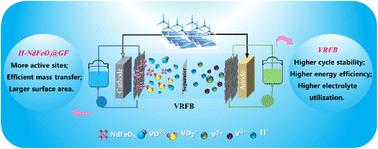解锁高效储能:钒氧化还原液流电池的阴极催化剂——钕铁氧体钙钛矿
IF 9.5
2区 材料科学
Q1 CHEMISTRY, PHYSICAL
引用次数: 0
摘要
开发高效的阴极催化剂是钒氧化还原液流电池发展的关键。本研究比较了水热法(H-NdFeO3@GF)和溶胶-凝胶法(SG-NdFeO3@GF)制备NdFeO3钙钛矿装饰石墨毡的方法,强调了结构和催化影响。H-NdFeO3@GF具有ABO3钙钛矿框架,Nd/Fe占据A/ b位点,形成三维互连的网状介孔结构,增强电子/离子传递和钒氧化还原动力学。在150 mA cm−2时,H-NdFeO3@GF在150次循环中表现出平滑的库仑效率(CE)和能量效率(EE)曲线,单次循环容量为39.6 Ah L−1(优于SG-NdFeO3@GF的26.2 Ah L−1)。在80-250 mA cm - 2的速率能力评估中,H-NdFeO3@GF即使在250 mA cm - 2下也能保持约65.23%的EE,而SG-NdFeO3@GF和传统GF (TGF)的效率下降更为严重。对于长周期稳定性,H-NdFeO3@GF实现78.87%的高EE(比TGF提高12.48%,比SG-NdFeO3@GF提高4.28%),并在150 mA cm - 2下维持1000次循环,每循环的EE衰减率最小为0.00352%。研究表明,水热合成可以调整钙钛矿的结晶度和碳基质整合,这对于暴露活性位点和提高耐久性至关重要。这些发现强调H-NdFeO3@GF是一种高性能的VRFB阴极催化剂,通过协同结构和合成工程为可扩展的储能提供了战略途径。本文章由计算机程序翻译,如有差异,请以英文原文为准。

Unlocking high-efficiency energy storage: neodymium ferrite perovskite as a cathode catalyst for vanadium redox flow batteries
Developing efficient cathode catalysts is pivotal for advancing vanadium redox flow batteries (VRFBs). This study compares hydrothermal (H-NdFeO3@GF) and sol–gel (SG-NdFeO3@GF) synthesis of NdFeO3 perovskite-decorated graphite felt, emphasizing structural and catalytic impacts. H-NdFeO3@GF features an ABO3 perovskite framework with Nd/Fe occupying A/B-sites, forming a three-dimensional interconnected network-like mesoporous structure that enhances electron/ion transport and vanadium redox kinetics. At 150 mA cm−2, H-NdFeO3@GF exhibits smooth coulombic efficiency (CE) and energy efficiency (EE) profiles over 150 cycles, with a single-cycle capacity of 39.6 Ah L−1 (outperforming SG-NdFeO3@GF's 26.2 Ah L−1). In rate capability evaluations across 80–250 mA cm−2, H-NdFeO3@GF retains ∼65.23% EE even at 250 mA cm−2, whereas SG-NdFeO3@GF and traditional GF (TGF) undergo more severe efficiency degradation. For long-cycle stability, H-NdFeO3@GF achieves a high EE of 78.87% (representing a 12.48% enhancement over TGF and a 4.28% improvement over SG-NdFeO3@GF) and sustains 1000 cycles at 150 mA cm−2 with a minimal EE decay rate of 0.00352% per cycle. The work demonstrates that hydrothermal synthesis tailors perovskite crystallinity and carbon-matrix integration, which are critical for exposing active sites and improving durability. These findings underscore H-NdFeO3@GF as a high-performance VRFB cathode catalyst, offering a strategic pathway for scalable energy storage through synergistic structural and synthetic engineering.
求助全文
通过发布文献求助,成功后即可免费获取论文全文。
去求助
来源期刊

Journal of Materials Chemistry A
CHEMISTRY, PHYSICAL-ENERGY & FUELS
CiteScore
19.50
自引率
5.00%
发文量
1892
审稿时长
1.5 months
期刊介绍:
The Journal of Materials Chemistry A, B & C covers a wide range of high-quality studies in the field of materials chemistry, with each section focusing on specific applications of the materials studied. Journal of Materials Chemistry A emphasizes applications in energy and sustainability, including topics such as artificial photosynthesis, batteries, and fuel cells. Journal of Materials Chemistry B focuses on applications in biology and medicine, while Journal of Materials Chemistry C covers applications in optical, magnetic, and electronic devices. Example topic areas within the scope of Journal of Materials Chemistry A include catalysis, green/sustainable materials, sensors, and water treatment, among others.
 求助内容:
求助内容: 应助结果提醒方式:
应助结果提醒方式:


